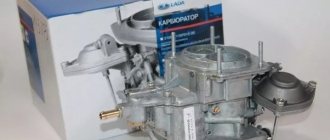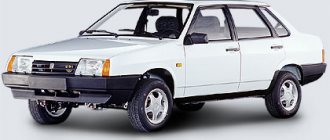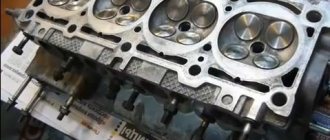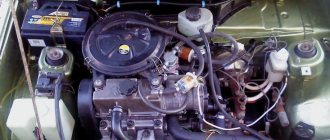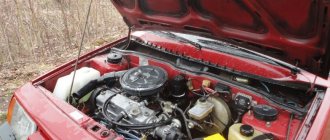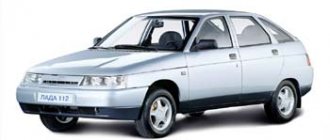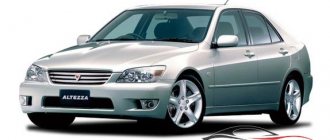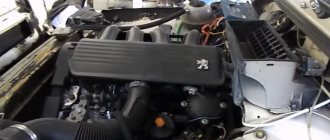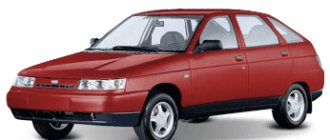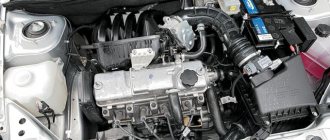A rather successful development of the domestic automobile industry was the VAZ 2107 engine, which provided 1690 cubic centimeters of displacement. These characteristics allow the power unit to develop a maximum power of 79 horsepower. In this case, the peak torque of the engine is 127 Nm at 3200 rpm.
The VAZ 2107 injection engine was slightly redesigned by the manufacturers, as they added single fuel injection. Thanks to this solution, the inline four-cylinder engine began to work much better, and problems with it arose much less frequently.
Specifications
| Engine capacity, cc | 1690 |
| Maximum power, hp | 79 |
| Maximum torque, N*m (kg*m) at rpm. | 127 (13) / 3200 |
| Fuel used | Gasoline AI-92 |
| Fuel consumption, l/100 km | 6.9 |
| engine's type | In-line, 4-cylinder |
| Add. engine information | single injection |
| Maximum power, hp (kW) at rpm | 79 (58) / 5200 |
| Number of valves per cylinder | 2 |
Swan song 2107 or interrupted flight
This version was discontinued either in 2002 or five years later. This inaccuracy is associated with the anarchy that reigned at that time on the VAZ assembly line and at the assembly facilities in Izhevsk. Then the sevens were assembled from what was available and few people thought about the conformity of the modification. In addition, there was a directive to reduce the cost of the car design as much as possible. For example, in the middle of the first decade of the 11th century, you could buy a seven with the following factory tuning:
There may be no ashtrays on the rear door cards;
soft two-layer plastic could be missing, and instead of it, ordinary oak plastic could easily be found;
the armrest handles could also be cast from this very hard plastic;
the horns in the latest versions resembled moped tablets, which, when first wet, emitted a gentle squeak instead of the powerful signal of the standard seven horn;
the door pillars are no longer painted black;
The combined moldings along the sides disappeared.
It was also often possible to find new sevens without headlight washers at all. But all this did not stop the public and they willingly bought cars. Habit is a great thing, it works better than any marketing. Do not offend the old sevens and they will serve faithfully for decades to come. Good roads and optimism to everyone!
The first “seven” rolled off the VAZ assembly line in 1982, and with its design it created a real sensation. In comparison with its predecessor, the “five”, it looked much more solid: a chrome radiator grille, an improved shape of the rear headlights, an updated instrument panel, complemented by a tachometer and a number of new sensors, and one-piece anatomical seats. For such “chic”, the VAZ 2107 was even called the Russian “Mercedes” in the southern regions of the USSR.
Peculiarities
The VAZ 2107 engine with an injector had a cylinder block made of high-quality cast iron. In it, all 4 cylinders are located in one row. The mass of the block is quite large, since it is the heaviest part of the structure, as it is made of cast iron.
The VAZ 2107 engine with a carburetor was also produced, and it was no different from its counterpart with an injector. The crankshaft was also made of cast iron, and it is placed on five supports, which are known among people as journals. The journals are hardened with high frequency current, and the crankshaft is machined with great precision.
Connecting rods are the parts that experience maximum loads in the structure, so forged steel was used for their production. The engine has 4 connecting rods - one for each cylinder. Inside there are piston pins that are installed from the factory. The markings on these parts correspond to the cylinders, since they cannot be swapped with each other.
The displacement of the VAZ 2107 engine is also achieved due to the fact that its pistons are cast from lightweight aluminum, as is the cylinder head. In order for the pistons to have better contact with the cylinder walls, a layer of tin is applied to the outer surfaces.
The gas distribution mechanism is driven by a chain. Together with it, there is a damper and tensioner, which manufacturers used for quieter operation of the power unit. But in practice this is practically not noticed.
The VAZ 2107 engine number, like most classic models from domestic manufacturers, is located near the oil filter. This is a kind of marking plate that is very difficult to confuse with other data, and is relatively easy to find.
How does the VAZ 2107 injection engine work?
In carburetor engines, air-fuel liquid is formed inside the carburetor chambers, and in injectors, fuel is injected directly into the cylinders. The engines of the seventh model have separate injection of 4 injectors for each cylinder.
The operation of each injector is monitored using a microcontroller located in the engine electronic control unit (ECU). The element’s task is to regulate the flow of the combustible mixture into the combustion chambers in accordance with the positions of the gas pedal, operating modes and other parameters that are read using special sensors and transmitted to the computer.
Main functions of the ECU - electronic control unit:
- Control of the amount of air and fuel entering the engine cylinders.
- Forming an ignition spark on the candles, setting the advance angle in accordance with engine speed.
- Turning the fuel pump on and off.
- Idle speed regulation.
- Controlling the amount of carbon dioxide contained in the exhaust.
- Monitoring the fluid temperature in the cylinder block cooling system.
The work occurs in accordance with a certain algorithm:
- Fuel from the gas tank enters a special distribution pipe - a ramp, where a pressure regulator is located that regulates the supply of fuel to the injectors. Here a constant pressure of 300 MPa is maintained, and excess gasoline is returned to the tank.
- The ECU controls the opening and closing of the injectors, supplying gasoline through the intake manifolds at each engine revolution.
- Depending on the length of time the injector opens, the amount of fuel supplied varies. The opening time is calculated based on sensor readings, the main ones being air flow and throttle valve position.
- The positions of the pistons in the cylinders also affect the moment the injectors open; the ECU receives data about this from the crankshaft sensor.
- No less important are such parameters as the temperature of the cooling system fluid, the voltage in the car’s electrical network, engine speed, and the content of gases in the exhaust.
The electronic ignition module in the VAZ 2107 includes a pair of coils and an electronic board. This unit is reliable and does not require regular maintenance. Depending on the number of crankshaft revolutions and thanks to signals coming from the electronic engine control unit, a spark is formed.
Advantages
That's what, and with positive qualities, domestic engines constantly have problems. But despite this, the advantages of such engines still exist, which is why they are used in cars even today. The main positive qualities are the following:
- Repairing a VAZ 2107 engine is very simple. Its design features mean that even capitalizing the engine will not be difficult. The cylinder walls are thick enough to allow the engine to be bored more than once.
- Easy to maintain. The simplest design of the motor means that it can be repaired from almost any breakdown without much difficulty. Owners of such cars carry with them only a minimum set of tools.
- The engine speed of the VAZ 2107 is distributed in such a way that the car with it under the hood is quite high-torque.
- Engine life is its main advantage. In practice, such engines can travel more than 200 thousand kilometers without the need for major repairs. Only in order to achieve such indicators is it necessary to properly maintain the power unit.
About classic engines!
Information on the sizes of VAZ classic engines:
Knee stroke 2101, 2103, 21213: stroke 2101 - 66mm (in everyday life called low) stroke 2103 - 80mm stroke 21213 - 80mm (more balanced due to more developed counterweights, apparently to the detriment of weight) stroke 2130 - 84mm There are Tyunen knees with a stroke of 84, 86.88 mm. But they cost from 10 thousand
The diameter of the pistons for the classic 2101 is 76mm 21011,2105 is 79mm 21213 is 82mm 2108 is 82mm (installed for driving on a 76 Benz, for export) There are many forged pistons of any stock diameter, and a maximum of 84mm. One of the main geometric characteristics of the piston is the compression height. It is determined by the distance from its bottom to the piston pin axis. For a classic VAZ engine it is 38 mm. There are pistons with a lower compression height, such as TPT pistons. The height is 31 mm.
Lengths of connecting rods for classic engines (what are there): All connecting rods 2101 are 136 mm long, but there is a connecting rod 213 that is the same length, but there the pin is pressed into the piston and not into the connecting rod. There are connecting rods that are shortened by 7mm (as an example: push the 80th knee into a low block) There are two types: shortened - they are made immediately 7mm shorter (they make them somewhere in Ukraine), and seated, that is, they take a stock connecting rod and shrink it under heat, they did it at scoop, but they are not very desirable, and in general opinion are dangerous, since there will certainly be tension at the place of shrinkage, and the “hand of friendship” may appear
We have an engine 2101 or 21011 with volumes of 1.2 and 1.3 respectively, what can we get? from 2101 blocks we can get volumes of 1.5 and 1.6 liters, from 21011 blocks 1.6 and 1.7. What is needed for this? 1. Crankshaft 2103 (if you hear a crankshaft 2106 or 2121, then keep in mind that the engine 2106 has a KV 2103, the Niva 2121(!) had a 2106 engine), or 21213 (it will be better) 2. Connecting rods Shortened, if we increase the volume connecting rods, then you can leave the original pistons, it all depends on the service life of the engine, if we sharpen then take new pistons) 3. Pistons (If we install original or 213 connecting rods)
the rest is according to Murzilka.
An example of obtaining 1.7 liters on block 011: 1. Crankshaft 2. Connecting rod 129 mm (as an option, either original or 213) 3. Pistons 82 mm (here it depends on the connecting rod, if it is shortened then we install a Nivov piston from engines 21213, if the connecting rod will be native or 213, then we install a piston with a lower compression height) 4. We sharpen the cylinders up to 82 mm This turns out to be 1.7 liters) For volumes 1.5 and 1.6 the same order, only we will choose between connecting rods and pistons, in In this case, there is such a thing as R/S (rod to stroke ratio) - the difference between the length of the connecting rod and the stroke of the crankshaft. And quite serious attention is paid to it when refining engines. Many sources believe that the “golden mean” is an R / S value of 1.75
Large R/S effect:
PRO: Allows the piston to remain at TDC longer, which ensures better combustion of the fuel mixture, i.e. more complete combustion of the fuel mixture, higher pressure on the piston after passing TDC, higher temperature in the combustion chamber. The result is good torque at medium and high speeds. A long connecting rod reduces friction of the piston-cylinder pair, and this is especially important during the working stroke of the piston.
CONS: A motor assembled with a sufficiently large R/S value does not provide good filling of the cylinders at low and medium HF rotation speeds, due to a decrease in air flow speed (due to a decrease in the piston speed after TDC, at the moment the intake valve opens). There is a high probability of detonation due to the high temperature in the combustion chamber and the long time the piston remains at TDC.
Small R/S effect:
PROS: Provides a very good cylinder filling speed at low and medium HF rotation speeds, since the piston speed from TDC is higher, the vacuum increases faster, which improves cylinder filling, a higher speed of the air-fuel mixture makes the mixture more homogeneous (homogeneous), which contributes to better combustion. Advantages: Lower requirements for rework and cylinder head bore diameters than on an engine with a high R/S ratio.
CONS: A small RS value means a larger crank angle. This means that a large force will push the piston in a horizontal plane. For the motor this means the following:
1. Large load on the connecting rod (especially on the center of the connecting rod), which makes destruction of the connecting rod more likely. Destruction of the connecting rod itself is unlikely, except in cases of breakage, when jamming and water hammer, as a rule, the connecting rod breaks at the upper or lower head at an angle of approximately 45 degrees to the axis of the connecting rod. 2. Increased load on the walls of the cylinder block, greater load on the pistons and rings, increased operating temperature due to increased friction, as a result, faster wear of the cylinder walls, rings, and deterioration of lubrication conditions. The wear of this area depends on the amount of displacement of the pin axis rel. piston axis and on the value of the maximum angle of inclination of the connecting rod, i.e. When using “forged” pistons with an offset pin, wear will be less than when using standard pistons. 3. A shorter connecting rod also increases the speed of the piston, which affects wear and increases friction. The maximum piston speed occurs at an angle of about 80 degrees of rotation of the crankshaft from TDC; for an engine with a 74.8 mm crankshaft at 5600 rpm it is equal to 22.92 m/s with a connecting rod of 121 mm, and 22.80 m/s. with a connecting rod of 129 mm.
The most significant is the dependence of the piston acceleration on the length of the connecting rod. Large acceleration values have a positive effect on cylinder filling at low speeds, which leads to a “torque” engine due to better filling. But at high speeds, due to the inertia of the flow in the intake pipe, a blocking effect occurs on the intake valve (that is, the volume of the cylinder above the piston grows faster than it can be filled through the valve gap, which leads to deterioration in filling and power characteristics at high speeds). In the case of a long connecting rod, a reverse ejection of the mixture occurs at low speeds, but at high speeds there is no locking phenomenon.
For obvious reasons, AVTOVAZ equips its engines with a 136 mm connecting rod (it provides the 06th engine with R/S = 1.7, which is quite satisfactory). But for “tuners” using CVs with a large crank radius, a connecting rod of 136 mm does not provide a very good R/S ratio, therefore, on the market of “non-standard”, a la “sports” spare parts, connecting rods with a length of 129, 132 mm exist and are sold , their price is really not so attractive, it ranges from 70 to 200 dollars per set. Also, do not forget that the “extra strokes” of the piston are compensated by reducing the compression height of the piston (by moving the piston pin upward) or by increasing the height of the cylinder block. Because the compression height can be reduced to a certain limit, then the next step will be to replace the cylinder block with a higher one, which will entail considerable financial expenses. All these actions are aimed at increasing the R/S value.
As a result, increasing the volume using a 129 mm connecting rod to 1.5 (1.6) liters, we get R/S - 1.61, which will give the engine tractor-like performance, i.e. effect of small R/S. When using pistons with a lower compression height, we do not change the R/S value, i.e. the characteristic will be the same as that of the 2106 engine - 1.7, which is “close to the golden mean”
1. Block 2101, initial volume 1200 cm2 KV - 2103 (21213) Piston - 76 (depending on repair: 76.4; 76.8) with reduced compression height We get 1.5 s R/S - 1.7 Result: Excellent motor almost 2103 due to an increase in the Compression Ratio (hereinafter referred to as Cr) for 92 gasoline
2. Block 2101, initial volume 1200 cm2 KV - 2103 (21213) Connecting rod 129 mm Piston - stock We get 1.5 with R/S - 1.61 Result: “Tractor” engine, will be better than 03 due to traction at the bottom, good for the city )
3. Block 21011, initial volume 1300 cm2 KV - 2103 (21213) Piston - 79 (depending on repair: 79.4; 79.8) with reduced compression height We get 1.6 with R/S - 1.7 Result: Excellent motor , it will be better than 06 due to the increase in SG
4. Block 21011, initial volume 1300 cm2 KV - 2103 (21213) Connecting rod 129 mm Piston - stock We get 1.6 with R/S - 1.61 Result: “Tractor” engine, will be better than 06 due to traction at the bottom, good for the city )
The 2101 and 21011 engines themselves have an R/S of 2.01 i.e. the engine is revving. Also, if we bore 2101 to 79 mm, we get a volume of 1300, i.e. 011 motor, but this is the very last gasp of the motor. Well, if you bore the 011 motor to 82 mm, then we get 1400 cubes, but just as in the first case it will be the last gasp of the motor, it is important not to overheat the motor, otherwise the block will go to the landfill.
The 2103 block can be sharpened up to 79 mm maximum, the 2106 block up to 82 mm. When boring, we get the following: 2103 bored to 79 with the KShM drain gets a volume of 1600 cm2 2106 bored to 82 with the KShM drain gets a volume of 1700 cm2
You can install Crankshaft with a stroke of 82 mm without changes 1. Block 2103 - 76mm (76.4; 76.8) KV - 82mm Total - 1487 cm2 (1502; 1518) * volume in brackets with repair dimensions
2. Block 2106 - 79 mm (79.4; 79.8) KV - 82 mm Total - 1606 cm2 (1623; 1639)
3. Block 2106 bored to 82 mm KV - 82 Result - 1731 cm2 But the engine’s last breath will be
cylinder volumes with repair piston sizes are not taken into account here
When forcing in these ways, it is important to know this:
Compression is the maximum air pressure in the combustion chamber at the end of the compression stroke.
The engine compression ratio is the ratio of the total volume of the cylinder (V) to the volume of the combustion chamber (Vc).
Total volume - cylinder volume + combustion chamber volume + cylinder head gasket volume.
E = V / Vc Both of these indicators are very important for assessing the overall power (E) and for assessing the condition of the motor (compression).
Source
Problems
Cars with such engines under the hood have enough problems with frequent breakdowns. We must not forget that the engine was designed by Soviet engineers, so its vulnerabilities outnumber its positive qualities. The most common engine breakdowns are as follows:
- It often happens that the VAZ 2107 engine fails. This is a common breakdown that is associated with the fact that the batteries fail. Here it is worth paying attention not only to the ignition and its components, but also to look at the fuel pump.
- The power of the VAZ 2107 engine may drop significantly, and this is very noticeable, since the car stops accelerating normally. This is the first sign that the valves need to be adjusted, since there are no hydraulic compensators in the system.
- Often you have to add oil to the VAZ 2107 engine. Here everything looks much sadder, since this is a signal that the engine is gradually coming to an end. It is worth preparing mentally and financially for the fact that you will have to do major repairs.
- The temperature of the VAZ 2107 engine may not reach operating parameters or the car begins to quickly overheat. Everything is simple here - as a rule, the reason for this phenomenon is that the thermostat gets stuck in a large or small circle, respectively.
Why do problems appear in the injection system?
Poor quality gasoline is the main cause of clogged injectors. The reason for this is paraffin deposits that settle on the walls and block the passage of fuel.
When producing high-quality fuel, manufacturers include in its composition special additives (detergents) that help dissolve heavy deposits. Low-quality fuels contain paraffin in excess quantities, which additives cannot cope with.
Low ambient temperature also has a negative impact on the intensity of formation of harmful deposits. Frequent operation of a car with a cold engine causes accelerated clogging of the injection system nozzles.
In addition to the injectors, the throttle valve also suffers from paraffin accumulations, which can cause a change in the proportions of air and fuel in the mixture supplied to the cylinders. Intake valves also collect heavy deposits on their surfaces, leading to burnout and detonation explosions.
You can clean the intake system of deposits yourself in a garage using a special flushing fluid and a syringe.
Procedure for flushing the injector:
- Mix gasoline with flushing fluid.
- Pour the solution into the system using the brake booster hose.
The solution is first started in small quantities with the engine off, then with the engine running. Neutralized deposits pass into the cylinders and are completely burned, as evidenced by smoke briefly coming out of the exhaust pipe.
Maintenance
In order to get trouble-free operation, as well as to guarantee that the engine will work for as long as possible, you need to properly maintain it. Fortunately, this is quite simple to do, since maintenance can be carried out even in the garage. Many people wonder how much oil is in the VAZ 2107 engine, and the answer is quite simple - the block is designed for 3.75 liters, but during replacement you need to fill in 3.5.
The valves on such an engine need to be adjusted every 10 thousand kilometers. But as practice shows, owners of cars with such a power unit under the hood only do this when the car stops moving. The gasoline filter needs to be changed every 15 thousand kilometers. The chain is tensioned every 40 thousand kilometers and must be replaced after 100 thousand kilometers.
What engine can be installed on this car?
Initially, 2 types of engines were installed on the VAZ 2107 model, these are:
Let's look at them next.
There were also 1.3 L and 1.2 L engines, but they are very few in number and practically never found.
It is also possible to install an engine from a VAZ with front-wheel drive, but it is too labor-intensive and unjustified.
This is interesting! Sometimes the English letter “i” is added before the name of the car. This means that the VAZ 2107 engine is an injector.
Injector – fuel sprayer. Nozzle. The principle of operation of injection gasoline engines is very similar to diesel engines.
Preparing for installation
Diesel engine d 240 technical characteristics
After purchasing all the necessary spare parts, you can begin upgrading. First you need to dismantle unnecessary equipment, in particular:
- loosen and remove the generator belt;
- remove the crankshaft pulley and camshaft drive cover;
- dismantle the distributor, fuel pump and switch;
- remove the carburetor and air filter;
- dismantle the old cylinder head along with the manifolds;
- unscrew the exhaust manifold and coolant distributor tee from the cylinder head (located in front of the manifolds in the direction of travel of the car);
- dismantle the accelerator drive rods, the gas pedal and unnecessary wires (to the coolant sensor, ECXX, distributor);
- remove the gas tank (if it will be replaced).
Next, preparatory activities should be carried out.
- Drill a hole on the ebb of the coolant distributor tee, screw a new antifreeze temperature sensor into it and install the tee on the new cylinder head.
- Secure the TPS in its proper place in the throttle valve assembly.
- Close the holes in the block left after removing the mechanical fuel pump and distributor with plugs.
- Extend the return line to the fuel tank, if there is none.
- Attach the electric fuel pump mounting bracket in the trunk or under the bottom and embed the fuel pump into the fuel supply hose.
